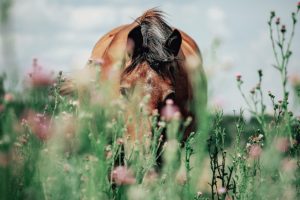Weight gain can be achieved in horses through accumulation of muscle, fat, or both. The weight gain that covers surface skeletal points, fills out the neck, and gives an overall smooth appearance constitutes an increase in fat tissue. This type of fat cover is considered “body condition,” even though it does not correlate to fitness. Muscle weighs more than fat, so gains in muscle mass may increase body weight and give a stronger, more athletic appearance but will not improve body condition.
For these reasons, this discussion, presented in Q&A format, will be focused on improving body condition without diminishing the importance of adequate protein in the diet to support muscle mass.
Calories to increase body fat can come from any of the following sources of nutrients alone or in combination: (1) digestible fiber as found in forages and by-product fiber sources like beet pulp; (2) nonstructural carbohydrates (NSC), primarily the starches and sugars found in grains and molasses; and (3) dietary fat found in oils, seeds, and high-fat by-products like rice bran.
Q: What’s the best approach for a horse that is coming out of winter skinny and clearly needs some “groceries”?
A: If a horse does not make it through the winter with optimal body condition, there are two options: let Mother Nature take its course or be proactive about weight gain. If you let Mother Nature decide, as the ambient temperatures rise, the horse will burn fewer calories to keep warm and dedicate more calories to fat accumulation. Often, just the presence of spring pasture grasses will increase the calorie intake of the horse sufficiently to put on weight, sometimes in excess. This is only relevant if a horse has access to pasture, however.
The other option, and probably necessary if a horse is getting back into training with an increased workload, would be to strategically boost caloric intake. The change in diet should be directly proportional to the amount of work the horse will be asked to do. If only a slight bump in body condition is needed without any significant increase in workload, then simply increasing the quality or quantity of fiber in the diet may be sufficient. This can be achieved through increasing the amount hay fed daily, feeding a higher quality hay, or adding an additional high-quality fiber source like alfalfa pellets or beet pulp. These potential changes in forage encourage weight gain in a safe way, as it does not involve changes in the glucose/insulin cycle that can be problematic for some horses.
For horses with an increased workload and no trouble with insulin regulation, calories can be increased by boosting feed intake. In these cases, increasing the amount of feed the horse is getting by a pound or two a day may suffice. Most modern horse feeds are a balance of fiber, starch, sugar, and fat with relative amounts of each dependent on the purpose of the feed. “Safe” feeds may be higher in digestible fiber, while “energy” feeds may contain more starch and fat. The perfect feed for a specific horse depends on many factors, including a horse’s general demeanor, excitability, insulin sensitivity, and other metabolic traits.
Other options for small increases in caloric intake might be to add vegetable oil (canola, soy), high-fat seeds like flax or sunflower, or rice bran. For horses without signs of insulin dysregulation, adding some oats or steam-flaked barley to the diet can increase the calories enough to add weight.
The amount of increased feed in the diet will depend on the individual horse, overall health, and activity level. Any changes or increases in feed intake should be done slowly. Offering several small meals of feed is preferable to one or two larger meals. A note of caution: once the desired body condition is achieved, the ration should be re-evaluated and the total calories may need to be reduced to keep the horse from gaining more weight than needed.
Q: What constitutes a healthy amount of weight gain without adding too much too quickly? What should we be looking for? Visual weight gain? Use a weight tape?
A: Accelerated weight gain can be problematic for some horses, such as those with a predisposition to insulin dysregulation or laminitis. It may also be challenging for joints, as they don’t have much time to adapt to the strain of the extra weight. Therefore, conservative weight gain is always prudent. A reasonable amount of gain would be one body condition score increase over 30-60 days, which would equate to around 50 lb (23 kg) for the average-sized horse. That would be around 1-1.5 lb (0.5-0.7 kg) of weight gain per day. Visual signs of increased body condition include filling in between and covering of individual ribs, rounding over the hipbones and croup, leveling across the back, and thickening of the neck.
Taking before and after pictures can sometimes help provide an unbiased look at weight gain. Subtle changes in weight may not be noticed if the horse is observed daily. A weight tape will also give an unbiased idea of how much weight is being gained over time. The weight tape may not reveal exact body weight but can be used to show a relative change over time as the girth grows. The trick is to place the tape in the exact same spot every time when assessing the horse’s weight, and this is often best accomplished by having the same person weigh each time.
Q: What nutrients are necessary for weight gain?
A: Key nutrients for weight gain include fermentable fiber, nonstructural carbohydrates (starch and sugar), and fat. Adequate dietary protein is also essential for healthy weight gain. If protein is in short supply, the body will break down its own muscle tissue to supply the body with the protein needed for critical body processes. The diet should also contain vitamins and minerals that are needed for building body tissues.
Q: Is laminitis a concern when adding weight?
A: Concern over laminitis would be highest with horses predisposed to insulin dysregulation. Those with a normal metabolism should be able to handle increases in concentrates without issue if they are made gradually. Also, if concentrate feedings are too large for any horse, more than 5 lb (2.3 kg) of concentrate in a feeding, then it is wise to split the daily total into more frequent meals. For example, if the horse needs 12 lb (5.5 kg) of feed daily, then it is better to feed three meals with 4 lb (1.8 kg) per feeding or four meals with 3 lb (1.4 kg) per feeding than two meals with 6 lb (2.7 kg) per feeding. This allows the digestive tract time to process the concentrate feed thoroughly without becoming overwhelmed.
Q: What are some general feeding guidelines for horses predisposed to laminitis?
A: Laminitis-prone horses should be managed carefully. They may not handle the high sugar content of spring pastures well and might require limited grazing time or a grazing muzzle. As for hay for this type of horse, it can be good quality but should have low NSC content, preferably less than 12%. If the hay is too high in NSC, it can be soaked for 30 minutes in hot water or 60 minutes in cold water, and drained to remove some of the sugar. Soaking leaches other nutrients from the hay, so it is important to ensure that the total diet is balanced and provides all essential nutrients.
Alternative fermentable fiber sources can be added to the diet, such as alfalfa or grass hay pellets, beet pulp, or coconut meal. If more calories are needed for weight gain in a laminitic-prone horse and they need a concentrate, then a low-NSC feed would be advisable. Many different low-NSC feeds are available. A simple low-NSC feed would be a ration balancer combined with alfalfa pellets.












